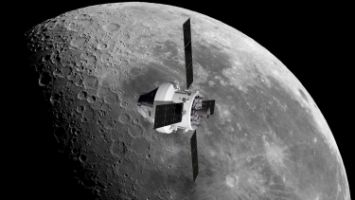How Tessella the data science & AI experts, created the algorithms that will fly ESA's Solar Orbiter around the Sun
CAPE CANAVERAL, Fla., Feb. 6, 2020 /PRNewswire-PRWeb/ -- The spacecraft - designed and built in the UK by Airbus Defence & Space (ADS) - will gather unprecedented data about the surface of the Sun. It will help us understand unpredictable solar weather, which is responsible for stunning auroras but can also damage electronics and electricity grids.
To gather this data, Solar Orbiter will travel inside Mercury's orbit to get up close and personal with the Sun (just 42 million km away).
Maintaining tight control of a spacecraft close to the Sun, where it can take detailed measurements without burning up, is challenging: "Like balancing on a tightrope with Mike Tyson punching you" says Tessella's Andrew Pollard, who worked on the control algorithms.
The spacecraft is protected by a heat shield on one side, which allows it to get so close to the sun. It is vital that this stays facing the Sun, or the sensitive instruments will be damaged. Meanwhile the measurement instruments need to point to specific spots on the Sun with an accuracy of 0.4 arcseconds over 10 seconds - the equivalent of pointing at a tennis ball steadily for 10 seconds whilst moving around it 25km away.
As part of its operation, the orbiter needs to move large appendages, such as solar panels and antennae, which can subtly affect the direction it is pointing. In addition, the spacecraft needs to be able to cope should equipment failures occur. In such scenarios, the spacecraft needs to remain protected by the heatshield and recover normal pointing accuracy quickly.
It must also operate in different modes throughout its lifetime to control its travel, and occasionally needs to use Venus and Earth's gravitational fields to perform 'slingshot' manoeuvres to reach new orbits.
So how are scientists delivering such precise control in a spacecraft - ensuring it stays on track and keeps pointing in the right direction - whilst operating millions of miles away?
The algorithms that keep Solar Orbiter on track
No one is 'flying' the orbiter, it has to navigate this hostile environment by itself, with only limited, infrequent communication with Earth.
This is done by the innovative Attitude & Orbit Control Subsystem (AOCS), which were developed by ADS, alongside Tessella (algorithms) and Terma (software).
The orbiter itself contains a number of navigation sensors: a star tracker (which calculates its position relative to astronomical bodies), gyroscopes, accelerometers, and a sun sensor. Using these it constantly 'looks around' and measures how it is moving, and uses the data it gathers to change its orientation and velocity
Such movement is done through a series of actuators - nine thrusters pairs and four reaction wheels - which allow considerable control of both the rotation and velocity, but also create considerable control complexity.
Turning the sensor data into instructions for the actuators requires very complex algorithms.
The algorithms in the Solar Orbiter driving seat
Tessella started developing the control system algorithms in 2012. The algorithms automatically process complex data gathered from the sensors, make sense of it to estimate orientation, and feed these into the control systems, which respond accordingly.
The algorithms fuse together multiple sensor data sets, and reduce the errors in individual sensors measurements. By combining these data sets, and using them to validate each other and spot likely errors, the orbiter can calculate where it is pointing and how fast it is moving.
They then calculate the error between the current and desired orientation and velocity. A series of equations turn this calculation into an instruction to the actuators which will correct its course.
Continuous adjustment will be required throughout the mission, and it is important these are precise - adjustments that are too large may require additional fuel to correct them, which is a limited resource.
Developing the algorithms involved in creating a detailed model of the spacecraft, which was used to simulate scenarios in space, including moving appendages, changing modes, and potential failures. All space missions are unique and control systems need to reflect their specific needs; for example, Solar Orbiter has lots of flexible parts which create oscillations, so models needed to take these specific dynamics into account.
Andrew Pollard says: "Understanding the spacecraft design is key to pinpointing discrepancies and resolving them. With a detailed model of the spacecraft, we can develop simulations, based on our understanding of physical forces in space, to understand how the spacecraft will react to a wide variety of common, and unusual scenarios, that could affect its trajectory. From there, we can develop, test and validate the algorithms that will guide it through its mission to study the Sun."
Download the Solar Orbiter case study
About Tessella
Tessella, Altran World Class Center for Analytics, is an international data science, analytics and AI technology consulting services provider. We partner with our clients to build exceptional digital business capabilities that connect people and data intelligently. With nearly four decades of hard-won experience across a range of industries, we are uniquely prepared for your toughest challenges. http://www.tessella.com
Media contact
Christina Tealdi | Senior PR and Marketing Communications Manager | Christina.tealdi@tessella.com
SOURCE Tessella






